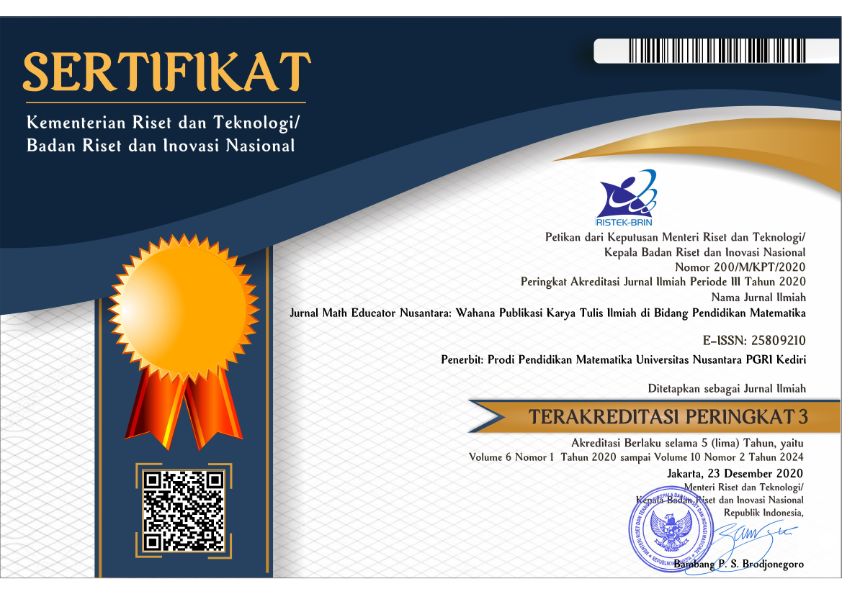Increasing student numeracy ability through learning e-module statistics integrated with flipbook and augmented reality
DOI:
https://doi.org/10.29407/jmen.v9i2.21302Keywords:
Numerasi;, E-modul Terintegrasi;, Statistika.Abstract
Abstract: This research was motivated by the low numeracy of students in statistics courses, which contradicts the importance of numeracy. For this reason, an integrated statistics e-module with a flipbook and augmented reality was developed with the aim that, through learning using this e-module, it can improve student numeracy. The use of flipbooks and augmented reality programs as an effort to integrate knowledge, pedagogy, and technology in an effort to improve numeracy. This research used quantitative methods, with the subjects being 58 students in statistics courses. The paired two-sample t-test technique was used to analyze the increase in numeracy through e-module learning. The data were analyzed with the help of the SPSS 21 for Windows program. The research results showed that there was an increase in student numeracy after using the e-module, with a significance value of 0.00 < 5% with t = -5.23> -t0.05, so learning using the statistics e-module integrated with flipbooks and augmented reality can improve student numeracy.
Keywords: Numeracy; Integrated E-module, Statistic.
References
Ahyan, S., Zulkardi, Z., & Darmawijoyo, D. (2014). Developing mathematics problems based on PISA level of change and relationships content. Journal on Mathematics Education, 5(1), 47-56. http://dx.doi.org/10.22342/jme.5.1.1448.47-56
Angela, F., Maimunah, M., & Roza, Y. (2021). Desain media pembelajaran komik matematika berbasis aplikasi android pada materi persamaan eksponensial. Jurnal Cendekia: Jurnal Pendidikan Matematika, 5(2), 1449-1461. https://doi.org/10.31004/cendekia.v5i2.437
Biber, A. Ç. (2014). Mathematics teacher candidates' skills of using multiple representations for division of fractions. Educational Research and Reviews, 9(8), http://dx.doi.org/237. 10.5897/ERR2013.1703.
Dwiranata, D., Pramita, D., & Syaharuddin, S. (2019). Pengembangan media pembelajaran matematika interaktif berbasis android pada materi dimensi tiga kelas x sma. Jurnal Varian, 3(1), 1-5. https://doi.org/10.30812/varian.v3i1.487.
Mahmud, M. R., & Pratiwi, I. M. (2019). Literasi numerasi siswa dalam pemecahan masalah tidak terstruktur. Kalamatika: Jurnal Pendidikan Matematika, 4(1), 69-88. https://doi.org/10.22236/KALAMATIKA.vol4no1.2019pp69-88.
Megantari, K. A., Margunayasa, I. G., & Agustiana, I. G. A. T. (2021). Belajar sumber daya alam melalui media komik digital. Mimbar PGSD Undiksha, 9(1), 139-149. https://doi.org/10.23887/jjpgsd.v9i1.34251
Muhammad, I., Elmawati, E., Samosir, C. M., & Marchy, F. (2023). Bibliometric Analysis: Research on Articulate Storylines in Mathematics Learning. EduMa: Mathematics Education Learning And Teaching, 12(1), 77-87. https://doi.org/10.17977/um038v4i32021p309.
National Council of Teachers of Mathematics. 2003. Curriculum and Evaluation Standards for School Mathematics. Reston, Virginia: NCTM
OECD. 2017. PISA for Development Assessment and Analytical Framework: Reading, Mathematics and Science (Preliminary). OECD Publishing.
Ojose, B. (2011). Mathematics literacy: Are we able to put the mathematics we learn into everyday use. Journal of mathematics education, 4(1), 89-100. .
Pribowo. 2018. Development of a Media Validation Instrument Based on the Surrounding Environment. Journal of Education & Science, 18(1):1–12. http://dx.doi.org/10.30651/didaktis.v18i1.13.
Purnama, SR., Kamilah, A., Damayanti, IM., Dari SW., Santia, I. 2023. Understanding Logarithmic Concept: How to Develop LOGAMATHICS Media Validity Instruments? International Journal of Research and Review, 10(8): 113-118. https://doi.org/10.52403/ijrr.20230816.
Santia, I. 2017. The Development of Mathematics Module Based on Relational Thinking. Education Emission of FKIP University of Jember, 6(4):49-58. https://doi.org/10.25037/pancaran.v6i4.88.
Santia, I., Fiantika, F. R., & Jatmiko, J. (2017). Pengembangan BKS berbasis MCK (mathematical content knowledge) sebagai upaya meningkatkan literasi matematika siswa SMP. Jurnal Math Educator Nusantara: Wahana Publikasi Karya Tulis Ilmiah Di Bidang Pendidikan Matematika, 3(2), 127-134. https://doi.org/10.29407/jmen.v3i2.909.
Santia, I. (2018). Analisis kemampuan literasi matematis siswa SMP berdasarkan motivasi belajar siswa. JIPMat, 3(2). https://doi.org/10.26877/jipmat.v3i2.2748
Santia, I., Purwanto, P., Subanji, S., Sudirman, S., & Akbar, S. (2019). Exploring Mathematical Representations in Solving Ill-Structured Problems: The Case of Quadratic Function. journal on mathematics education, 10(3), 365-378. https://doi.org/10.22342/jme.10.3.7600.365-378.
Santia, I., & Sutawidjadja, A. (2021, February). Characteristics of Prospective Student Teacher’s Representation in Solving Ill-Well Algebraic Problems. In Journal of Physics: Conference Series (Vol. 1779, No. 1, p. 012001). IOP Publishing. https://iopscience.iop.org/article/10.1088/1742-6596/1779/1/012001/meta
Sari, T. T., & Cahyono, A. H. (2020). Development of Android-Based E-Learning" Fun Math" as an Alternative to Learning Mathematics in the Middle of a Pandemic. On line, 4(2). https://jcup.org/index.php/cendekia/article/downloa d/355/235/ 11.
Supardi, A. A., Gusmania, Y., & Amelia, F. (2019). Pengembangan modul pembelajaran matematika berbasis pendekatan konstruktivisme pada materi logaritma. AKSIOMA: Jurnal Matematika Dan Pendidikan Matematika, 10(1), 80-92. https://doi.org/10.26877/aks.v10i1.3744
Thiagarajan, S., Semmel, DS., & Semmel, MI. 1974. Instructional Development for Training Teachers of Exceptional Children. Bloomington: Indiana University.
Rumiati, S. W. (2011). Instrumen Penilaian Hasil Belajar Matematika SMP: Belajar dari PISA dan TIMSS. Yogyakarta: Pusat Pengembangan Dan Pemberdayaan Pendidik Dan Tenaga Kependidikan (PPPPTK) Matematika, 55. http://repositori.kemdikbud.go.id/id/eprint/15137
Downloads
Published
Issue
Section
License
Authors who publish with this journal agree to the following terms:
- Copyright on any article is retained by the author(s).
- The author grants the journal, the right of first publication with the work simultaneously licensed under a Creative Commons Attribution License that allows others to share the work with an acknowledgment of the work’s authorship and initial publication in this journal.
- Authors are able to enter into separate, additional contractual arrangements for the non-exclusive distribution of the journal’s published version of the work (e.g., post it to an institutional repository or publish it in a book), with an acknowledgment of its initial publication in this journal.
- Authors are permitted and encouraged to post their work online (e.g., in institutional repositories or on their website) prior to and during the submission process, as it can lead to productive exchanges, as well as earlier and greater citation of published work.
- The article and any associated published material is distributed under the Creative Commons Attribution-ShareAlike 4.0 International License















